Image sharpening / Haze Reduction
Haze Reduction is IP module that reduces to damp haze or fog in images; it can improve the visibility and readability by digital image processing.
We can offer you “Haze Reduction” as the hardware implemented IP for security or surveillance camera or system.
You can see and experience the image with abundant colors by mounting the image sharpening to general video camera.
■FEATURE
1.Real time image sharpening by hardware
We implement the algorithm of sharpening image to the hardware, and it makes the input full hi-vision, even bigger than one.
The size how it can be processed is depended on the size of line buffer and the operation speed of the hardware.
For example, it’s able to show you the processed image of full frame rate with full hi-vision size at FPGA implementation.
“Haze Reduction” is sharpening the image acquired from sensor in earlier stages by implementing to the video equipment hardware. It’s possible to keep the high image quality herewith.
Also it’s possible to play the high image quality as video in real time by all means.
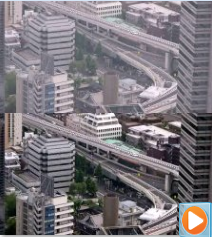
Comparative Example Download image sharpening
(avi Video、31M)
The top is the original image. Bottom is the processed
image of image sharpening.
2. Intensity adjustment is processed per pixel.
It sharpens the image that has a haze or fog with the effective method as image enhancement process per pixel.
It processes strongly in the part where the dense fog has, and it doesn’t need to process in the part where doesn’t have the fog a lot.
In consequence, it has even repeatability.
In the image at left side, the part of branch in this image has light haze, so it doesn’t need to process Haze Reduction strongly.
By contraries, the part of the grass and building in this image has a dense fog, so there needs to process Haze Reduction strongly. Finally, it makes clear picture.
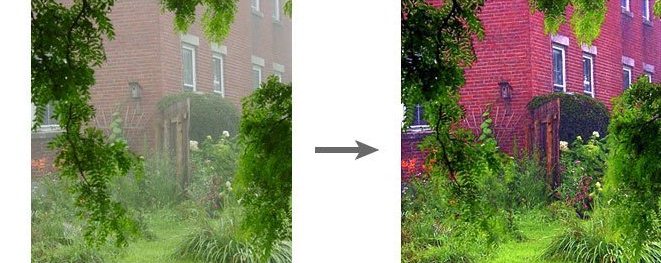
Processing before After treatment
3. Neighborhood processing
It can optimize the intensity of adjustment as the function of the dense of haze or fog.
It configures the right pixel size of haze or fog, and measures the neighborhood, and then it decides the intensity of adjustment after smoothing keep not going overboard.
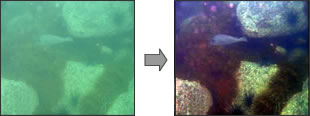 under the water
under the water
4. Intensive the disturbance
We can fulfill the real time video processing by implement the transmission map of neighborhood processing of pixel and reduction process per pixel to the hardware. By this process, we can offer you the firm image even it was the high frame rate video; like the image effected by strong wind, moving the object and so on...
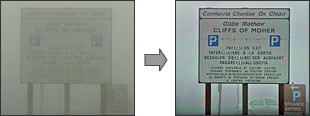
foggy
5. The change in a moment of processing parameter.
The changing is reflected as quickly as thought, because the parameter of extraction process is implemented to hardware.
It can preset the setting followed a system architecture as the implementation of processing parameter to video equipment, such as reflected the condition of input image, then change the parameter by external processor.
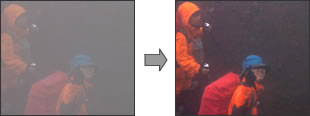
misty day
■The processing architecture of the image sharpening
Haze Reduction has the three function blocks, “Dynamic range correction”, “Haze Reduction process” and “Tone mapping.”
In the design of implement to hardware, it is important the circuit size; on the other hand, in this time it’s going to be important the functional architecture and parameter setup to get the result as application.
It is possible for setting each parameter of three blocks IP; that will get the processing result which application needs by combination of function blocks, and it’s possible to be a functions in point with optimizing the circuit.
For example, the image that almost part is not dark, it can remove the tone mapping.
- ※Patent pending(PATPEND)
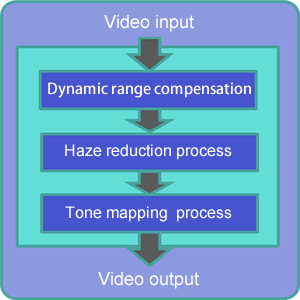
1.Dynamic range correction
First, we make sharpen the input image by compensating the brightness of whole image.
Processing parameter can be changed to the credit of processing.
And you can choose specialized one that processes optimized for the underwater.
These parameters are set from external of IP.
The basic construction of input image is captured to line buffer.
- ※It is possible to use the frame buffer at constitution option.

Input image (before processing)
![]()
2. Image sharpening/Haze reduction process
Step1: Transmission map
For sharpening image in the first stage need to create the taransmission map with scanning original one. Estimate the thick of fog per pixel for reducing the damp haze or fog.
transmission map(Image sharping)
Step2: Smoothing
It may not be satisfied only by estimated information; there may be bigger phase than a little different from.
It tries to get more natural processing result by polishing the dense of fog as it appears the photos before processing result if you use directed.

smoothing
Step3: Eliminating process
In the final step, It eliminates the haze or fog per pixel by using the information of the dense of haze or fog above processes.

Haze Reduction
3. Tone mapping
It can make improvements the dark image as appropriate.
※It is optional function. It’s off at the default.
■ Contact
NIPPON SYSTEMWARE CO., LTD. (NSW)
Product Solutions Group, Sales Division
2-15, Nanpeidai-cho, Shibuya-ku, Tokyo 150-0036, Japan
TEL: 03-4335-2610 FAX: 03-4335-2651
E-mail: Embedded-Info@gw.nsw.co.jp

